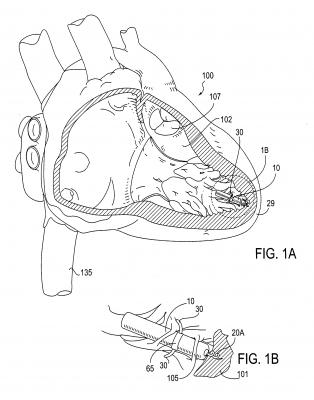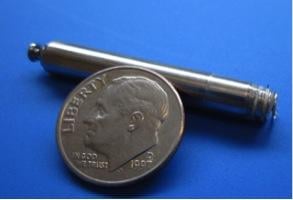
May 14, 2013 – The first patient tests of a new leadless pacemaker show that the device can deliver the same life-saving therapy as a traditional single-chamber pacemaker without potential lead-related complications. The findings are part of the LEADLESS trial and were released at Heart Rhythm 2013, the Heart Rhythm Society’s 34th Annual Scientific Sessions.
While conventional pacemakers are overall safe and effective, the device leads, or wires that are implanted into the heart, can cause complications such as fracture or infection. The new percutaneously-delivered leadless pacemaker is implanted directly into the heart, eliminating the need for leads. The LEADLESS trial is a prospective, non-randomized, single arm study that evaluated the safety of the device as well as right ventricular (RV) pacing function, battery longevity, rate response, implant success rate and procedure times.
The Nanostim Inc. leadless cardiac pacemaker is an entirely self-contained intra-cardiac device with a screw-in active fixation mechanism. After placing an 18 French sheath in the femoral vein, the device is delivered to the right ventricle using a deflectable delivery catheter with an extendable sleeve to protect the fixation helix. Once positioned, the sleeve is retracted and the device is undocked from the delivery catheter while maintaining a tethered connection to permit device measurements and assess stability. If the position is suboptimal, the leadless pacemaker can be re-engaged, unscrewed and repositioned.
“Leadless pacemakers are a promising new technology that could eliminate one of the biggest complication risks with these life-saving devices – the lead,” said lead author Vivek Reddy, M.D., professor of cardiology, Mount Sinai School of Medicine, and director of the cardiac arrhythmia service at Mount Sinai Hospital. “Our initial experience indicates that the procedure is faster and minimally invasive compared to traditional implantation surgery, which may dramatically improve recovery times for patients.”
Leadless pacemakers were implanted in 33 patients with bradycardia indications for a VVI pacemaker. The device was successfully implanted in 97 percent of the patients through femoral venous access using a deflectable delivery catheter under X-ray guidance. The mean procedure time was 28 minutes and device performance was evaluated at two days, two weeks, six weeks and three months after surgery. The pacing threshold, R-wave amplitude and impedance were all comparable to that of a conventional pacemaker and the battery life is approximately 8-17 years depending on pacing needs.
The small size of the device, less than 10 percent the size of a conventional pacemaker, allows for percutaneous placement through the femoral vein with a steerable catheter. Even with miniaturization, initial results indicate battery longevity is comparable to conventional pacemakers, with an average lifespan of 8.5 years at 100 percent pacing.
The study is being conducted in Europe to gather data in support of CE mark approval. Devices were implanted at Homolka Hospital, Prague, Czech Republic; Academic Medical Center (AMC) Hospital in Amsterdam, the Netherlands; and Institute for Clinical and Experimental Medicine (IKEM) Hospital in Prague, Czech Republic. The study’s principal investigator is Johannes Sperzel, M.D., at the Kerckhoff Klinic in Bad Nauheim, Germany.
“We are looking forward to the potential benefits this technology will be able to offer our patients,” said Petr Neuzil, M.D., head of cardiology at Homolka Hospital in Prague, Czech Republic. “The elimination of the surgical pocket and lead has the potential to reduce long-term patient complications.”
In a conventional pacemaker procedure, an incision is made in the upper chest and one or more leads are guided through a vein into the heart. The pacemaker is then connected to the lead(s) and inserted beneath the skin and the incision closed. Nanostim’s leadless pacemakers are implanted via a percutaneous, catheter-based procedure. The devices are placed directly into the heart and are designed without the requirement for a lead or surgical pocket.
The Nanostim approach is designed to improve patient comfort by giving the physician a less-invasive option, permitting implantation as an outpatient and eliminating the visible lump and scar at a conventional pacemaker’s pectoral implant site. Because of the elimination of the lead, the device is inherently MRI compatible and also removes the need for activity restrictions to prevent dislodgement after implantation of a conventional lead.
“We’re excited with these outstanding preliminary results,” said Drew Hoffmann, chief executive officer of Nanostim Inc. “We remain confident that the LEADLESS study will further our understanding of the benefits of this innovative, minimally-invasive technology and look forward to making this important technology available to patients and physicians worldwide.”
For more information: www.HRSonline.org

